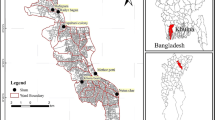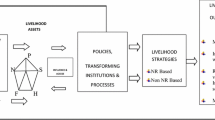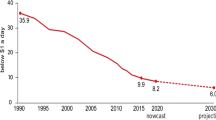Abstract
Urban poverty is a complex phenomenon and people experiencing poverty suffer from various deprivations. Multidimensional poverty measurement has been one of the best indicators of this deprivation. In general, slum dwellers are considered homogenous groups, but it is not valid in multidimensional deprivation. This paper aims to find out the correlates of multidimensional poverty in slums. Spatiality and correlates of poverty in Varanasi City have been tapped using statistical modelling. The paper is based on primary data collected from 384 households through an interview schedule from 12 slums across three geographical zones of the city. The MPI index for slums, based on global MPI, was used to compute MPI for each geographical zone. Further ANOVA and hierarchical regression analysis were performed to find spatiality and correlates of multidimensional deprivation. The paper reveals that socio-religious categories, occupation and geographical location are significant determinants or at least correlates of multidimensional poverty in slums.


Similar content being viewed by others
Data availability
The datasets generated during and/or analyzed during the current study are available from the corresponding author on reasonable request.
References
Abd Manap, N., Zakaria, Z., & Hassan, R. (2017). Investigation of poverty indicators for designing case representation to determine urban poverty. International Journal of Advances in Soft Computing and Its Applications, 9(2), 90–106.
Alkire, S. (2007). The missing dimensions of poverty data: Introduction to the special issue. Oxford Development Studies, 35(4), 347–359. https://doi.org/10.1080/13600810701701863
Alkire, S., & Foster, J. (2011). Counting and multidimensional poverty measurement. Journal of Public Economics, 95(7), 476–487. https://doi.org/10.1016/j.jpubeco.2010.11.006
Alkire, S., Kanagaratnam, U., & Suppa, N. (2021). The global multidimensional poverty index (MPI) 2021 (No. 51, pp. 1–39). Oxford Poverty and Human Development Initiative (OPHI).
Alkire, S., & Santos, M. E. (2014). Measuring acute poverty in the developing world: Robustness and scope of the multidimensional poverty index. World Development, 59, 251–274. https://doi.org/10.1016/j.worlddev.2014.01.026
Alkire, S., & Seth, S. (2015). Multidimensional poverty reduction in India between 1999 and 2006: Where and how? World Development, 72, 93–108. https://doi.org/10.1016/j.worlddev.2015.02.009
Ariyanto, K. (2023). Literature review: Urban poverty in a sociological perspective. Antroposen: Journal of Social Studies and Humaniora, 2(1), 24–32.
Arora, A., & Singh, S. P. (2015). Poverty across social and religious groups in Uttar Pradesh: An interregional analysis. Economic and Political Weekly, 50(52), 100–109.
Bansal, S., Pandey, V., & Sen, J. (2017). Redefining and exploring the smart city concept in indian perspective: Case study of Varanasi. In F. Seta, J. Sen, A. Biswas, & A. Khare (Eds.), From poverty, inequality to smart city. Springer. https://doi.org/10.1007/978-981-10-2141-1_7
Belhadj, B. (2011). A new fuzzy unidimensional poverty index from an information theory perspective. Empirical Economics, 40, 687–704. https://doi.org/10.1007/s00181-010-0368-5
Bhasin, R. (2001). Urban poverty and urbanization. Deep and Deep Publications.
Bhaumik, S., & Chakrabarty, M. (2010). Earnings inequality in India: Has the rise of caste and religion-based politics in India had an impact? In A. Shariff & R. Besant (Eds.), Handbook of Muslims in India (pp. 1–32). Oxford University Press.
Borooah, V. K. (2005). Caste, inequality and poverty in India. Review of Development Economics, 9(3), 399–414. https://doi.org/10.1111/j.1467-9361.2005.00284.x
Borooah, V. K., Diwakar, D., Mishra, V. K., Naik, A. K., & Sabharwal, N. S. (2014). Caste, inequality and poverty in India: A re-assessment. Development Studies Research. an Open Access Journal, 1(1), 279–294. https://doi.org/10.1080/21665095.2014.967877
CDP, 2015. City development plan for Varanas-2041. Capacity Building for Urban Development Project, Ministry of Urban Development. Retrieved from, https://openjicareport.jica.go.jp/pdf/12250312_03.pdf
Cochran, W. G. (1963). Sampling techniques (2nd ed.). John Wiley and Sons Inc.
Deaton, A. & Dreze, J. (2002). Poverty and inequality in India: A re-examination. Economic and Political Weekly, 37(36), 3729–3748.
Dinzey-Flores, Z. (2017). Spatially polarized landscapes and a new approach to urban inequality. Latin American Research Review, 52(2), 241–252.
Dubey, A. and Gangopadhyay, S., (1998). Counting the Poor: Where are the Poor in India? Department of Statistics, Government of India.
Fahad, S., Nguyen-Thi-Lan, H., Nguyen-Manh, D., Tran-Duc, H., & To-The, N. (2023). Analyzing the status of multidimensional poverty of rural households by using sustainable livelihood framework: Policy implications for economic growth. Environmental Science and Pollution Research, 30, 16106–16119. https://doi.org/10.1007/s11356-022-23143-0
Field, A. (2013). Discovering statistics using IBM SPSS Statistics: And sex and drugs and rock ‘n’ roll (4th ed.). Sage.
Gang, I. N., Sen, K., & Yun, M. S. (2002). Caste, Ethnicity and Poverty in Rural India. Retrieved from IZA Institute of labour economics website: https://www.iza.org/publications/dp/629/caste-ethnicity-and-poverty-in-rural-india
Gotham, K. F. (2003). Toward an understanding of the spatiality of urban poverty: The urban poor as spatial actors. International Journal of Urban and Regional Research, 27(3), 723–737. https://doi.org/10.1111/1468-2427.00478
Gounder, N. (2013). Correlates of Poverty in Fiji: An analysis of individual, household and community factors related to poverty. International Journal of Social Economics, 40(10), 923–938. https://doi.org/10.1108/IJSE-2012-0067
Gutschow, N. (2006). Benares: The sacred landscape of Vārānasī. Edition Axel Menges.
Hagerty, M. R., Cummins, R., Ferriss, A. L., Land, K., Michalos, A. C., Peterson, M., Sharpe, A., Sirgy, J., & Vogel, J. (2001). Quality of life indexes for national policy: Review and agenda for research. Bulletin of Sociological Methodology/bulletin De Méthodologie Sociologique, 71(1), 58–78. https://doi.org/10.1177/075910630107100104
Halimatusa’diyah, I. (2015). Zakat and social protection: The relationship between socio-religious CSOs and the government in Indonesia. Journal of Civil Society, 11(1), 79–99. https://doi.org/10.1080/17448689.2015.1019181
Harvey, D. (1993). From space to place and back again: Reflections on the condition of postmodernity. In J. Bird, B. Curtis, T. Putnam, G. Robertson, & L. Tickner (Eds.), Mapping the futures: Local cultures, global change. Routledge. https://doi.org/10.4324/9780203977781
Hashmi, A. A., Sial, M. H., Hashmi, M. H., & Anwar, T. (2008). Trends and determinants of rural poverty: A logistic regression analysis of selected districts of Punjab [with comments]. The Pakistan Development Review, 47(4), 909–923.
Haughton, J., & Khandker, S. R. (2009). Handbook on poverty + inequality. The World Bank.
Jamal, H. (2005). In search of poverty predictors: The case of urban and rural Pakistan. The Pakistan Development Review, 44(1), 37–55.
Jayaraj, D., & Subramanian, S. (2010). A Chakravarty-D’Ambrosio view of multidimensional deprivation: Some estimates for India. Economic and Political Weekly, 45(6), 53–65.
Jha, D. K., Harshwardhan, R., & Tripathi, V. K. (2019). Geographical zones of Varanasi City: Past to present. National Geographical Journal of India, 65(1), 46–55.
Jha, D. K., & Tripathi, V. K. (2014). Quality of life in slums of Varanasi city: A comparative study. Transactions, Journal of the Indian Institute of Geographers, 36(2), 171–183.
Jha, D. K., & Tripathi, V. K. (2018). Designing multidimensional poverty index for slums: Concept. Methodology and Interpretation, the Geographer, 65(1), 39–49.
Joshi, E. B. (1965). Uttar Pradesh district gazetteers Agra. Government of Uttar Pradesh.
Kaibarta, S., Mandal, S., Mandal, P., Bhattacharya, S., & Paul, S. (2022). Multidimensional poverty in slums: An empirical study from urban India. GeoJournal, 87(Suppl 4), 527–549. https://doi.org/10.1007/s10708-021-10571-7
Khalaj, S., & Yousefi, A. (2015). Mapping the incidence and intensity of multidimensional poverty in Iran urban and rural areas. The Journal of Spatial Planning, 18(4), 49–70.
Khan, A. U., Saboor, A., Ali, I., Malik, W. S., & Mahmood, K. (2016). Urbanization of multidimensional poverty: Empirical evidences from Pakistan. Quality & Quantity, 50, 439–469. https://doi.org/10.1007/s11135-014-0157-x
La Ferrara, E., & Bates, R. H. (2001). Political competition in weak states. Economics & Politics, 13(2), 159–184. https://doi.org/10.1111/1468-0343.00088
Löw, M., & Steets, S. (2014). The spatial turn and the sociology of built environment. In S. Koniordos & A. Kyrtsis (Eds.), Routledge handbook of European sociology (pp. 211–224). Routledge Handbooks Online.
Meenakshi, J. V., Ray, R., & Souvik, G. (2000). Estimates of poverty for SC, ST and female-headed households. Economic and Political Weekly, 35(31), 2748–2754.
Morris, M. D. (1980). The physical quality of life index (PQLI). Development Digest, 18(1), 95–109.
Mukim, M., & Panagariya, A. (2012). Growth, openness and the socially disadvantaged. In J. Bhagwati & A. Panagariya (Eds.), India’s reforms: How they produced inclusive growth. Oxford University Press. https://doi.org/10.1093/acprof:oso/9780199915187.003.0005
Nafees, N. A., Iqbal, J., & Haq, Z. U. (2022). Assessing modified multidimensional poverty index and its demographic correlates in Khyber Pakhtunkhwa. Journal of Policy Research, 8(3), 1–10. https://doi.org/10.5281/zenodo.7075729
Narayana, M. R. (2009). Education, human development and quality of life: Measurement issues and implications for India. Social Indicators Research, 90(2), 279–293. https://doi.org/10.1007/s11205-008-9258-z
Ong, P. M., & Miller, D. (2005). Spatial and transportation mismatch in Los Angeles. Journal of Planning Education and Research, 25(1), 43–56. https://doi.org/10.1177/0739456X04270244
Osmond, M. W., & Grigg, C. M. (1978). Correlates of Poverty: The interaction of individual and family characteristics. Social Forces, 56(4), 1099–1120. https://doi.org/10.2307/2577513
Panagariya, A., & More, V. (2014). Poverty by social, religious and economic groups in India and its largest states: 1993–1994 to 2011–2012. Indian Growth and Development Review, 7(2), 202–230. https://doi.org/10.1108/IGDR-03-2014-0007
Pandey, M. D., Nathwani, J. S., & Lind, N. C. (2006). The derivation and calibration of the life-quality index (LQI) from economic principles. Structural Safety, 28(4), 341–360. https://doi.org/10.1016/j.strusafe.2005.10.001
Perry, B. (2002). The mismatch between income measures and direct outcome measures of poverty. Social Policy Journal of New Zealand, 19, 101–127.
Piazza, J. A. (2006). Rooted in poverty? Terrorism, poor economic development and social cleavages. Terrorism and Political Violence, 18(1), 159–177. https://doi.org/10.1080/095465590944578
Poon, F. B. (2009). Spatial inequality of urban poverty in Hong Kong. (Thesis). University of Hong Kong, Pokfulam, Hong Kong SAR. https://doi.org/10.5353/th_b4292997
Rahi, M. (2011). Human development report 2010: Changes in parameters and perspectives. Indian Journal of Public Health, 55(4), 272. https://doi.org/10.4103/0019-557x.92404
Rupasingha, A., & Goetz, S. J. (2007). Social and political forces as determinants of poverty: A spatial analysis. The Journal of Socio-Economics, 36(4), 650–671. https://doi.org/10.1016/j.socec.2006.12.021
Saboor, A., Khan, A. U., Hussain, A., Ali, I., & Mahmood, K. (2015). Multidimensional deprivations in Pakistan: Regional variations and temporal shifts. The Quarterly Review of Economics and Finance, 56, 57–67. https://doi.org/10.1016/j.qref.2015.02.007
Saunders, P., Bradshaw, J., & Hirst, M. (2002). Using household expenditure to develop an income poverty line. In Social policy and administration. Blackwell Publishers.
Shukla, R., Jain, S., & Kakkar, P. (2010). Caste in a different mould. Business Standard, New Delhi. Retrieved from, https://ssrn.com/abstract=3297408
Singh, R. P. (2017). Varanasi, the heritage capital of India: Valuing the Sacredscapes. In Book of abstracts, international seminar on Indian art heritage in a changing world: Challenges and prospects (Vol. 27, pp. 19–38).
Singh, R. P., Dar, V., & Rana, P. S. (2001). Rationales for including Varanasi as heritage city in the UNESCO World Heritage List. National Geographical Journal of India, 47(1–4), 177–200.
Sirgy, M. J., Michalos, A. C., Ferriss, A. L., Easterlin, R. A., Patrick, D., & Pavot, W. (2006). The quality-of-life (QOL) research movement: Past, present and future. Social Indicators Research, 76(3), 343–466. https://doi.org/10.1007/s11205-005-2877-8
Smith, D. (1994). Geography and social justice. Blackwell.
Soja, E. W. (2019). The city and spatial justice. In Public Los Angeles. https://doi.org/10.4000/BOOKS.PUPO.415
Spinks, C. (2001). A new apartheid? Urban spatiality, (fear of) crime and segregation in Cape Town, South Africa. Development Studies Institute, London School of Economics and Political Science. Retrieved from, https://www.files.ethz.ch/isn/138143/WP20.pdf
Sulaiman, J., Azman, A., & Khan, Z. (2014). Re-modeling urban poverty: A multidimensional approach. International Journal of Social Work and Human Services Practice, 2(2), 64–72. https://doi.org/10.13189/ijrh.2014.020209
Sumarto, S., Suryadarma, D., & Suryahadi, A. (2007). Predicting consumption poverty using non-consumption indicators: Experiments using Indonesian data. Social Indicators Research, 81(3), 543–578. https://doi.org/10.1007/s11205-006-0023-x
Sundaram, K. & Tendulkar, S. D. (2003). Poverty among social and economic groups in India in 1990s. Economic and Political Weekly, 38(50), 5263–5276.
Thorat, S., & Dubey, A. (2012). Has growth been socially inclusive during 1993–94–2009–10. Economic and Political Weekly, 47(10), 43–53.
Xhafaj, E., & Nurja, I. (2014). Determination of the key factors that influence poverty through econometric models. European Scientific Journal, 10(24). https://doi.org/10.19044/ESJ.2014.V10N24P%25P
Zhou, Q., Chen, N., & Lin, S. (2022). A poverty measurement method incorporating spatial correlation: A case study in Yangtze River Economic Belt, China. ISPRS International Journal of Geo-Information, 11(1), 50. https://doi.org/10.3390/ijgi11010050
Funding
No funding was received to assist with the preparation of this manuscript.
Author information
Authors and Affiliations
Contributions
Both authors contributed to the study’s conception and design. Material preparation, data collection, and analysis were performed by Dr DKJ. The first draft of the manuscript was written by Dr DKJ. Both authors read and approved the final manuscript.
Corresponding author
Ethics declarations
Conflict of interest
The authors have no relevant financial or non-financial interests to disclose.
Ethical approval
Approval was obtained from the Departmental Research Committee, Department of Geography, Institute of Science, Banaras Hindu University, Varanasi, India. The procedures used in this study adhere to the tenets of the Declaration of Helsinki.
Additional information
Publisher's Note
Springer Nature remains neutral with regard to jurisdictional claims in published maps and institutional affiliations.
Rights and permissions
Springer Nature or its licensor (e.g. a society or other partner) holds exclusive rights to this article under a publishing agreement with the author(s) or other rightsholder(s); author self-archiving of the accepted manuscript version of this article is solely governed by the terms of such publishing agreement and applicable law.
About this article
Cite this article
Jha, D.K., Tripathi, V.K. Unveiling the complexity of urban poverty: Exploring spatial and multidimensional deprivation in slums of Varanasi, India. GeoJournal 88, 6561–6575 (2023). https://doi.org/10.1007/s10708-023-10986-4
Accepted:
Published:
Issue Date:
DOI: https://doi.org/10.1007/s10708-023-10986-4




